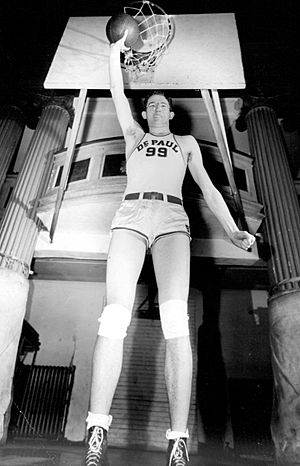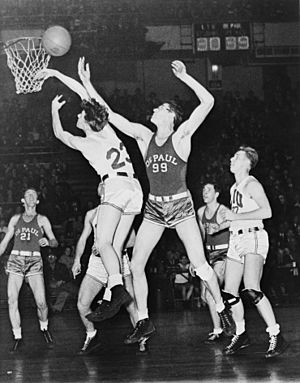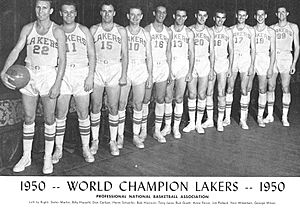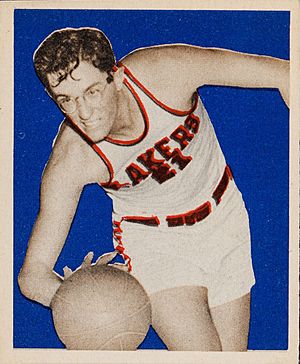George Mikan facts for kids

Mikan in 1945
|
|
| Personal information | |
|---|---|
| Born | June 18, 1924 Joliet, Illinois, U.S. |
| Died | June 1, 2005 (aged 80) Scottsdale, Arizona, U.S. |
| High school | Joliet Catholic (Joliet, Illinois) |
| Listed height | 6 ft 10 in (2.08 m) |
| Listed weight | 245 lb (111 kg) |
| Career information | |
| College | DePaul (1942–1946) |
| Pro career | 1946–1954, 1956 |
| Coaching career | 1957–1958 |
| Career history | |
| As player: | |
| 1946–1947 | Chicago American Gears |
| 1947–1954, 1956 | Minneapolis Lakers |
| As coach: | |
| 1957–1958 | Minneapolis Lakers |
| Career highlights and awards | |
|
|
| Career NBL/BAA/NBA statistics | |
| Points | 11,764 (22.6 ppg) (NBL / BAA / NBA) 10,156 (23.1 ppg) (BAA / NBA) |
| Rebounds | 4,167 (13.4 rpg) (NBA last five seasons) |
| Assists | 1,245 (2.8 apg) (BAA / NBA) |
George Lawrence Mikan Jr. (born June 18, 1924 – died June 1, 2005) was an American professional basketball player. He was known as "Mr. Basketball." George Mikan played for the Chicago American Gears and the Minneapolis Lakers. He was one of the first "big men" to dominate basketball.
Mikan was 6 feet 10 inches tall and wore thick glasses. He changed the game with his strong rebounding, shot blocking, and special hook shot. His coach, Ray Meyer, helped him develop the famous Mikan Drill. Mikan also shot free throws underhanded, like Rick Barry later did.
Mikan had a very successful career. He won seven championships in nine seasons. He also won an NBA All-Star Game MVP award and three scoring titles. Mikan was so good that he caused several important rule changes in the NBA. These included the goaltending rule, making the foul lane wider (called the "Mikan Rule"), and creating the shot clock.
After playing, Mikan helped start the American Basketball Association (ABA). He was the league's first commissioner. He also helped create the Minnesota Timberwolves. Later in life, Mikan fought to get better pensions for older players. He passed away in 2005 due to health problems.
For his amazing achievements, Mikan was put into the Naismith Memorial Basketball Hall of Fame in 1959. He was also named to the NBA's 25th, 35th, 50th, and 75th Anniversary Teams. A statue of Mikan shooting his hook shot stands at the entrance of the Timberwolves' arena.
Contents
Early Life and College Years
George Mikan was born in Joliet, Illinois. His family came from Croatia and Lithuania. When he was a boy, he hurt his knee badly and had to stay in bed for a long time.
Mikan went to DePaul University in 1942. He was 6 feet 10 inches tall and weighed 245 pounds. He moved a bit awkwardly and wore thick glasses. He didn't seem like a future athlete at first.
Becoming a Basketball Star
In high school, Mikan met Ray Meyer, a young basketball coach at DePaul. Meyer saw Mikan's potential. He believed tall players could be great. Meyer helped Mikan become a confident and strong player. Mikan learned to shoot hook shots with both hands. This training became known as the Mikan Drill. Meyer also made Mikan do other exercises, like punching a speed bag and jumping rope. This helped him become a complete athlete.
Mikan was amazing in college games. He was very strong and hard to stop. His hook shot was almost impossible to block. He also surprised everyone by swatting balls away from the basket. This led to a new rule. The NCAA and later the NBA made it illegal to touch a ball after it reached its highest point or hit the backboard.
Mikan was named the best college player in 1944 and 1945. He was an All-American three times. In 1945, he led DePaul to win the NIT title. This was a very important championship at the time. Mikan scored 53 points in one game, which was a huge amount!
Professional Career
Starting in the NBL
After college, Mikan joined the Chicago American Gears in the NBL. This league was a step before the NBA. He played well and was named MVP of a big tournament.
The Gears team later folded. Mikan then joined the Minneapolis Lakers. This was a lucky break for the Lakers!
Dominating with the Minneapolis Lakers
In his first year with the Lakers, Mikan led the NBL in scoring. He was the only player to score over 1,000 points that season. He was named the league's MVP, and the Lakers won the NBL title.
The next year, the Lakers joined a new league called the Basketball Association of America (BAA). Mikan again led the league in scoring. The Lakers won the BAA Finals in 1949.
In 1949, the BAA and NBL joined together to form the National Basketball Association (NBA). Mikan continued to be amazing. He averaged 27.4 points per game and won another scoring title. The Lakers had a great record and won the first-ever NBA championship in 1950. Mikan was a huge reason for their success.
In the 1950–51 season, Mikan scored a career-best 28.4 points per game. He also led the league in rebounds with 14.1 per game. That year, the NBA saw a very unusual game. The Fort Wayne Pistons played Mikan's Lakers. The Pistons were ahead 19–18. To keep Mikan from scoring, they just passed the ball around without shooting! There was no shot clock yet to make them shoot. This game helped lead to the invention of the shot clock later on. Mikan scored 15 of his team's 18 points in that game!
The "Mikan Rule" and More Championships
For the 1951–52 season, the NBA made the foul lane wider. It went from 6 feet to 12 feet. This was called "The Mikan Rule." It made it harder for tall players like Mikan to stay close to the basket. Even with this rule, Mikan still scored 23.8 points per game. He also grabbed 13.5 rebounds per game. In one game, he scored 61 points and had 36 rebounds!
The Lakers kept winning. They reached the NBA Finals in 1952 and beat the New York Knicks. Mikan was double-teamed a lot, but the Lakers still won their third championship.
In the 1952–53 season, Mikan averaged 20.6 points and a league-high 14.4 rebounds per game. He won the All-Star Game MVP award that year. The Lakers won another NBA title, beating the Knicks again.
By the 1953–54 season, Mikan was 29 years old. He still led the Lakers to another NBA title. This was their third championship in a row and fifth in six years! The only time they lost was when Mikan had a broken leg. The Lakers' dynasty was one of the best in NBA history.
Retirement and Comeback
After the 1954 season, Mikan decided to retire. He wanted to spend more time with his family. He had also suffered many injuries, including 10 broken bones.
Mikan returned to play for the Lakers in the middle of the 1955–56 season. But his long break had affected his game. He retired for good at the end of that season. At the time, his 10,156 points were an NBA record. He was the first NBA player to score 10,000 points.
BAA/NBA Career Statistics
| Legend | |||||
|---|---|---|---|---|---|
| GP | Games played | GS | Games started | MPG | Minutes per game |
| FG% | Field goal percentage | 3P% | 3-point field goal percentage | FT% | Free throw percentage |
| RPG | Rebounds per game | APG | Assists per game | SPG | Steals per game |
| BPG | Blocks per game | PPG | Points per game | Bold | Career high |
Regular season
| Year | Team | GP | MPG | FG% | FT% | RPG | APG | PPG |
|---|---|---|---|---|---|---|---|---|
| 1948–49† | Minneapolis | 60 | – | .416 | .772 | – | 3.6 | 28.3* |
| 1949–50† | Minneapolis | 68 | – | .407 | .779 | – | 2.9 | 27.4* |
| 1950–51 | Minneapolis | 68 | – | .428 | .803 | 14.1 | 3.1 | 28.4* |
| 1951–52† | Minneapolis | 64 | 40.2 | .385 | .780 | 13.5* | 3.0 | 23.8 |
| 1952–53† | Minneapolis | 70 | 37.9 | .399 | .780 | 14.4* | 2.9 | 20.6 |
| 1953–54† | Minneapolis | 72 | 32.8 | .380 | .777 | 14.3 | 2.4 | 18.1 |
| 1955–56 | Minneapolis | 37 | 20.7 | .395 | .770 | 8.3 | 1.4 | 10.5 |
| Career | 439 | 34.4 | .404 | .782 | 13.4 | 2.8 | 23.1 | |
| All-Star | 4 | 25.0 | .350 | .815 | 12.8 | 1.8 | 19.5 | |
Playoffs
| Year | Team | GP | MPG | FG% | FT% | RPG | APG | PPG |
|---|---|---|---|---|---|---|---|---|
| 1949† | Minneapolis | 10 | – | .454 | .802 | – | 2.1 | 30.3 |
| 1950† | Minneapolis | 12 | – | .383 | .788 | – | 3.0 | 31.3 |
| 1951 | Minneapolis | 7 | – | .408 | .800 | 10.6 | 1.3 | 24.0 |
| 1952† | Minneapolis | 13 | 42.5 | .379 | .790 | 15.9 | 2.8 | 23.6 |
| 1953† | Minneapolis | 12 | 38.6 | .366 | .732 | 15.4 | 1.9 | 19.8 |
| 1954† | Minneapolis | 13 | 32.6 | .458 | .813 | 13.2 | 1.9 | 19.4 |
| 1956 | Minneapolis | 3 | 20.0 | .371 | .769 | 9.3 | 1.7 | 12.0 |
| Career | 70 | 36.6 | .404 | .786 | 13.9 | 2.2 | 24.0 | |
Life After Playing Basketball
In 1956, Mikan ran for United States Congress in Minnesota. He lost by a small number of votes. He then focused on his law career.
In 1957, Mikan briefly coached the Lakers. But the team didn't do well, and he stepped down. He then became a successful lawyer, working with companies and real estate.
Commissioner of the ABA
In 1967, Mikan became the first commissioner of the American Basketball Association (ABA). This was a new league that competed with the NBA. Mikan came up with the idea for the ABA's famous red, white, and blue basketball. He thought it would be more exciting for TV and fans. He also brought in the three-point line, which the NBA later adopted.
Mikan left the ABA in 1969. But the league continued until 1976.
Bringing Basketball Back to Minnesota
In the 1980s, Mikan worked to bring professional basketball back to Minneapolis. The Lakers had moved to Los Angeles in 1960. His efforts led to the creation of the Minnesota Timberwolves in 1989.
Later Years and Legacy
Later in life, Mikan faced health problems, including diabetes. He had to have his right leg amputated. He also fought a long legal battle against the NBA. He wanted to get better pensions for players who retired before 1965. These players received much less money than later players. Mikan hoped to see a new agreement that would help his generation of players.
George Mikan passed away on June 1, 2005. His death brought attention to the financial struggles of many early NBA players. Shaquille O'Neal, a famous basketball star, even paid for Mikan's funeral. He said, "Without number 99 [Mikan], there is no me."
Mikan is seen as a pioneer of modern basketball. He was the first great center. He scored 11,764 points in his career. He won seven championships and many awards. He was inducted into the Basketball Hall of Fame in 1959. The Mikan Drill is still used by basketball players today.
A statue of Mikan stands at the entrance of the Minnesota Timberwolves' arena. A banner in the Lakers' arena also honors him. In 2022, the Lakers retired Mikan's No. 99 jersey.
How George Mikan Changed Basketball Rules
George Mikan was so dominant that the NBA had to change its rules because of him:
- The "Mikan Rule": The foul lane under the basket was made wider, from 6 feet to 12 feet. This forced big players to shoot from further away.
- The Shot Clock: Mikan's dominance in low-scoring games helped lead to the creation of the shot clock. This rule makes teams shoot the ball within a certain time limit.
- Goaltending: In college, Mikan was so good at blocking shots near the basket that the NCAA made a rule against "goaltending." This means you can't touch the ball once it's on its way down or has hit the backboard.
As a commissioner, Mikan also helped create the ABA's three-point line. This line was later adopted by the NBA. He also helped bring the Minnesota Timberwolves team to life.
See also
 In Spanish: George Mikan para niños
In Spanish: George Mikan para niños
- List of National Basketball Association single-game scoring leaders
- List of National Basketball Association annual scoring leaders
- List of National Basketball Association annual rebounding leaders
- List of NBA players with most championships
- List of Croatian Americans




